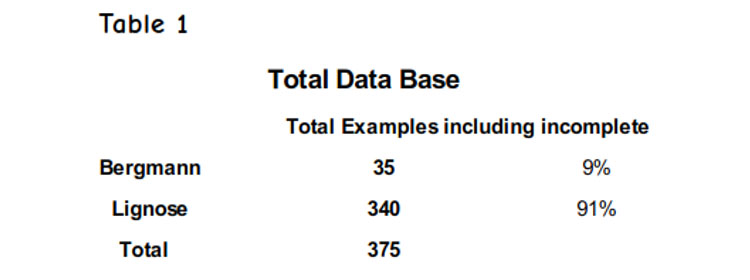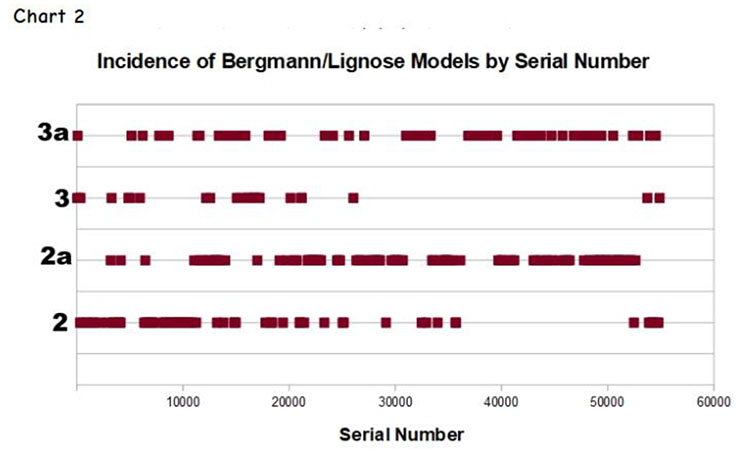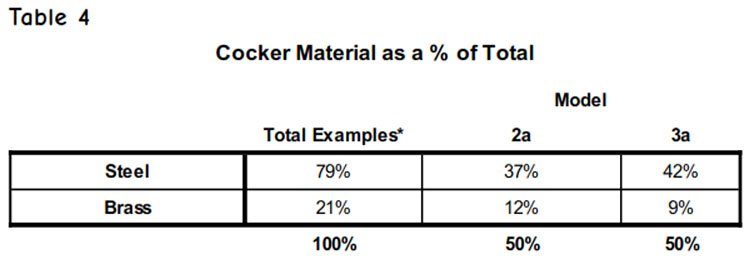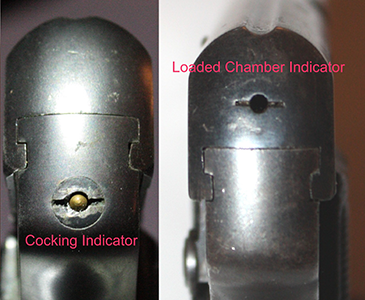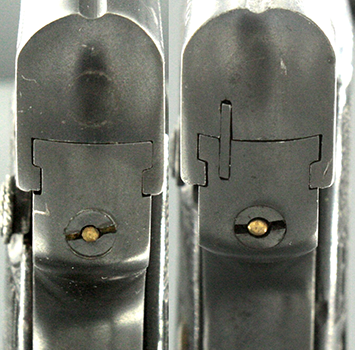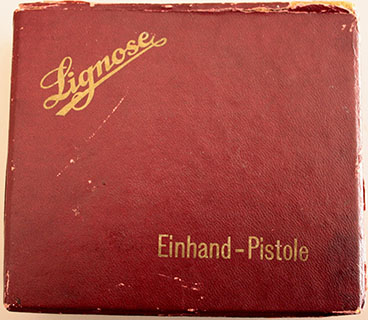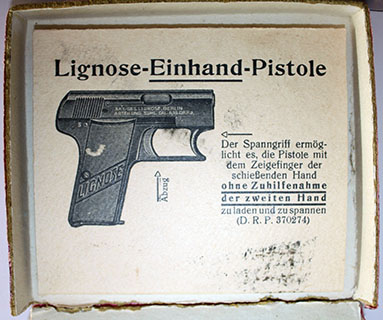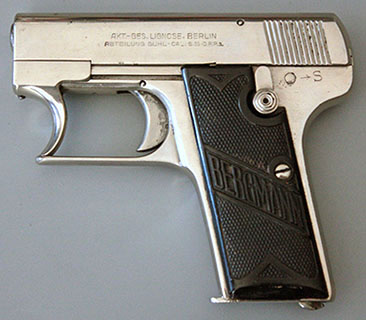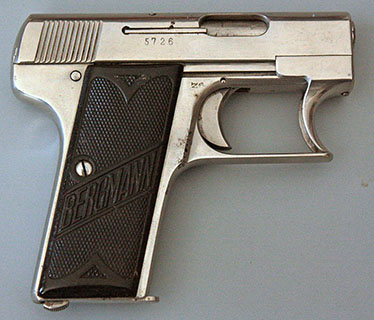 |
||||||||||||||||||||||||||||||||||||||||||||||||||||||||||||||||||||||||||||||||||||||||||||||||||||||||||||||||||||||||||||||||||
|
Patterns of Production: by Ed Dittus ed@Myakka.com
A full description of these interesting weapons was written by Ed Buffaloe and can be found here: https://unblinkingeye.com/Guns/Lignose/lignose.html I personally find these things interesting as a collecting objective inasmuch as they begin with number 1 and end at ~55000 with a small number of variations. These pistols have the common courtesy to end their run and not rattle on with many manufacturers and thousands of variations like some less mannerly weapons that I could name (cough Luger cough). Also, there is no evidence of a cottage industry devoted to faking them. I became interested in these pistols some time ago and compiled a database of serial numbers and other information from various sources. I thought that it might interest collectors if I shared some general
findings that I gleaned from this information. The database contains 375 entries of which 360 are for complete pistols which allows for a deeper level of analysis.
As shown in Table 1, Bergmann examples are fairly rare. Note that “pure Bergmann” examples are somewhat less common than that inasmuch as after Bergmann's acquisition various Bergmann parts were sold with Lignose grips and, presumably, other Lignose manufactured parts.
Table 2, below, shows the percent occurrences of each model by manufacturer. Interestingly, the Bergmann Company's sales were of the classic pistol design ie. not Einhand (81% vs. 19%) while the reverse was true for the Lignose Company (75% Einhand vs. 25%). Whether this reflects marketing direction or production issues is unknown.
Table 3 shows the overall incidence of Model by Manufacturer. Here we see that while Bergmann manufactured pistols are somewhat rare, their Einhand models are quite scarce, followed closely by the larger non Einhand #3.
While the Lignose models are generally far more common, their #3 model, too, is scarce. The reasons for this are open to speculation but it seems that the consumer benefit of a larger, non
Einhand, pistol is not terribly apparent compared to the other models.
A question that is worthy of exploration is what, if any, pattern existed for production of the various Bergmann/Lignose models. A casual examination of the data suggests that there was no particular system to production. To examine this a bit more objectively I simply plotted each model by it's serial number.
Up to approximately serial number 30000 it appears that all models are represented. After that point the non Einhand models seem to have been de-emphasized. In fact, Model #3 appears to have not been produced from serial 30000 until near the end of the run of these pistols. The reasons for this change doubtless have some roots in the dynamics of the civilian pistol market in Germany which leads us into a world of speculation.
Another variation that will confront the collector is the material from which the “cocker” is fabricated. Both brass and steel examples are to be found. “None” indicates the non Einhand #2 and #3 models. One might speculate that since about mid-way during the life of this weapon, at about the time brass was supplanted by steel as the cocker material, Germany's hyperinflation was peaking and that cost had an impact on the choice of material.
We can see from Table 4 that the majority of Einhand pistols were constructed using steel for the cocker. I have not noted any observations as to the serviceability of brass used in this application. I own a number of pistols with brass cockers and they work as well as the steel examples with no particular troublesome patterns or wear. Perhaps there was an opportunistic purchase of a large quantity of brass material. There is no obvious answer. The division between models is reasonably even within material. This simply suggests that the manufacturer switched over to steel from brass without regard to model. The counts within manufacturer are too small for any meaningful comparisons.
I recently bought a Bergmann #2 sn5xx. When I examined it I noticed a slot in the rear of the frame and slide.
The picture shows this feature on the right, next to an unmodified frame on the left. The slots in frame and slide are filled with an elongation of the ejector. And what is the purpose of this modification? I think that this was done to ease the disassembly and reassembly of the pistol. Models without this feature require the slide to be positioned so that the extractor is cleared before the slide can engage the rails on the frame. A bit tricky since the recoil spring has to be maintained in position during this process. The modified pistol allows the slide to engage the rails in a forward position allowing for the recoil spring to sort of sit naturally as the slide engages. The slot on the slide allows the ejector to enter the frame and that funny little extension on the rear of the ejector simply fills the opening when the pistol is assembled. So what I think we have here is a factory mod that might have been implemented on a limited test basis. It was non-trivial inasmuch as the frame did not receive the cut out required for the other models and the slide was machined with that rear slot. Probably a bit of Germanic over engineering that addressed a problem that might not have been as compelling as was thought. I would like to know if anyone else has an example showing this modification. I suspect a few more were made, whether they survived is another story. The Lignose Company, after ceasing production of pistols, became involved with the motion picture industry from a technical standpoint. The history of this company, as with so many other modest concerns of the period, remains to be explored.
An ancillary part of collecting is the opportunity to find related objects that add to one's understanding by either providing explanation of function or the physical context that the object was in back in the day. To that end we, as collectors of firearms, value things like photographs that show them in use or as part of military regalia. One type of object is truly ephemeral in that, being made of paper or cardboard, the boxes that they came in are often lost or terribly damaged. I was fortunate to come across an original Lignose Einhand box and a page of instructions on the pistols' operation and maintenance.
The picture on the left shows the top of the box, the one on the right shows a tipped-in illustration of the pistol it contained. Below is the instruction sheet that was folded inside. Given that this specimen is 100 years old, give or take, the condition is remarkably good.
As has been amply discussed, the Lignose Company acquired the Bergmann Einhand and vest pocket pistols around 1921. As part of this deal they obtained parts, some stamped with the Bergman name, some not. Lignose management, not really caring a fig for the headaches and mental acrobatics they might cause collectors a hundred years in the future, sensibly used everything they could. Where they had parts that were indelibly marked “Bergmann” they used them with gleeful abandon. These appear to have been predominantly grips. In fact, we see Bergmann grips pretty consistently on pistols with serial numbers into the 9000's, perhaps 4000 higher than when the assets were acquired. We also see Bergmann marked slides interspersed with those marked Lignose. Because of the use of Bergmann parts by Lignose, presumably from the time of the acquisition, it is virtually impossible to associate a pistol with Lignose markings as being the “FIRST” pistol made by Lignose. We collectors, as devotees of Baseball, revel in “records” even if they are followed by a stream of asterisks and annoyingly exculpatory footnotes. While there might not be a pistol that without doubt was the first one off the line with the Lignose name, one might find a Lignose marked pistol with the lowest serial number. Now, I had, for a period, owned the lowest marked Lignose. A Mighty Feat that was supplanted in short order. Recently, though, I came across a Lignose with the serial 5726 that is the lowest number in the data base (which now numbers 399 examples and can be accessed here: https://tinyurl.com/3rhkm6zk As can be seen, the Lignose name on the slide makes it's appearance with serial 5726 and increasingly supplants the Bergmann name, presumably as Bergmann parts were depleted. It is speculation, but not unreasonable, to assume that the workers came across a serialized slide and appropriated it. The frame is numbered in the mag well as well as the barrel too so perhaps there was a complete pistol that was uncovered. No way of knowing. The present example is a 3A (long grip, Einhand) and is nickel plated.
The Bergmann and Lignose Pocket and Vestpocket Pistols, by Ed Buffaloe |
||||||||||||||||||||||||||||||||||||||||||||||||||||||||||||||||||||||||||||||||||||||||||||||||||||||||||||||||||||||||||||||||||
|
Copyright 2025 by Ed Dittus. All rights reserved. |
||||||||||||||||||||||||||||||||||||||||||||||||||||||||||||||||||||||||||||||||||||||||||||||||||||||||||||||||||||||||||||||||||
|
|
||||||||||||||||||||||||||||||||||||||||||||||||||||||||||||||||||||||||||||||||||||||||||||||||||||||||||||||||||||||||||||||||||
